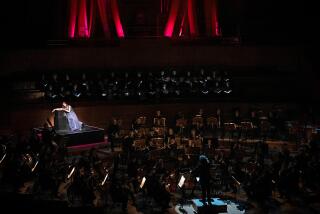MUSIC REVIEW : Scholarly Program Yields but a Few Smart Sounds
- Share via
FULLERTON — Most ensembles today routinely look back into history with programs that revolve around music of the 18th and 19th centuries, with a little cautious tiptoeing into our own. Musica Pacifica--which played Sunday afternoon at Sunny Hills High School as part of the Fullerton Friends of Music series--delves further back.
A focus on “early” music often means that period instruments are used and that, as in this case, the performers are scholars. Great benefits can accrue from a knowledgeable approach. But pitfalls can await if historical enlightenment takes precedence over musical potency.
On this occasion, we experienced both the advantages and the drawbacks. The concert--titled “Purcell’s World,” a nod to the 300th anniversary of the English composer’s death--included samplings of influential Renaissance and Baroque styles in tidy, stylistically aware readings. Yet only a few emerged compelling.
Among the latter, Purcell’s own works reigned. The lively imitation and touching harmonies of his Sonata in Three Parts, No. 1, in G minor for violin, oboe and continuo found crisp animation in the hands of violinist Elizabeth Blumenstock, oboist Gonzalo Ruiz and continuo players Steven Lehning (viola da gamba) and John Butt (harpsichord). With Judith Linsenberg on recorder, the musicians engaged in witty interplay during “Three Parts Upon a Ground.”
Some works floundered in interpretive blandness, such as Gottfried Finger’s “Division on a Ground” for recorder and continuo. Others, such as Marin Marais’ Suite in C minor for recorder, violin and continuo, seemed deserving of the oblivion to which time has already consigned them.
More to Read
The biggest entertainment stories
Get our big stories about Hollywood, film, television, music, arts, culture and more right in your inbox as soon as they publish.
You may occasionally receive promotional content from the Los Angeles Times.










